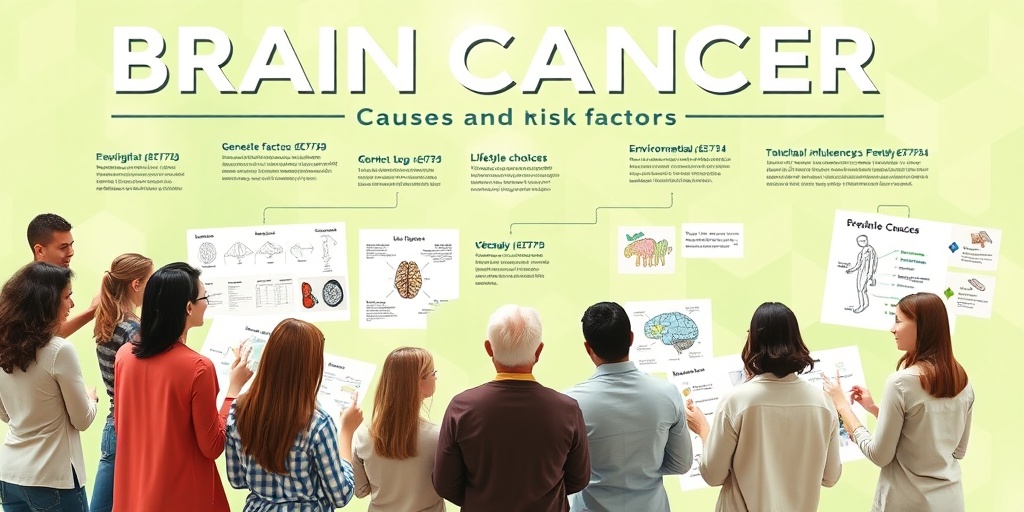What Is Brain Cancer?
Brain cancer refers to the abnormal growth of cells in the brain or surrounding tissues. These tumors can be classified as either primary, originating in the brain itself, or secondary, which means they have spread from other parts of the body. Understanding brain cancer is crucial, as it can significantly impact an individual’s health and quality of life.
Types of Brain Cancer
There are several types of brain cancer, each with its own characteristics and treatment options. Some of the most common types include:
- Gliomas: These tumors arise from glial cells and can be further categorized into astrocytomas, oligodendrogliomas, and ependymomas.
- Meningiomas: These tumors develop in the meninges, the protective layers surrounding the brain and spinal cord.
- Medulloblastomas: Typically found in children, these tumors originate in the cerebellum.
- Schwannomas: These tumors arise from Schwann cells, which produce the myelin sheath that insulates nerves.
Each type of brain cancer has its own survival rate and treatment protocols, making it essential for patients to receive a proper diagnosis and tailored treatment plan.
Understanding Brain Cancer Stages
Brain cancer is also categorized into stages, which help determine the extent of the disease and the most effective treatment options. The stages range from Stage I, which is localized and less aggressive, to Stage IV, where the cancer has spread extensively. Knowing the stage of brain cancer is vital for both patients and healthcare providers in planning the best course of action.
Brain Cancer Symptoms
Recognizing the symptoms of brain cancer is crucial for early diagnosis and treatment. Symptoms can vary widely depending on the tumor’s size, location, and growth rate. Here are some common symptoms to watch for:
Common Symptoms of Brain Cancer
- Headaches: Persistent or worsening headaches that may be different from typical headaches.
- Seizures: New-onset seizures can be a significant indicator of brain cancer.
- Changes in Vision: Blurred or double vision, or sudden loss of vision.
- Difficulty with Balance: Trouble walking or maintaining balance can signal brain issues.
- Cognitive Changes: Memory problems, confusion, or difficulty concentrating.
- Personality Changes: Unexplained changes in mood or behavior.
Brain Cancer Symptoms in Females
While the symptoms of brain cancer are generally similar across genders, some studies suggest that females may experience unique symptoms or different tumor types. For instance, hormonal factors may influence the development of certain types of brain tumors in women. It’s essential for females to be aware of these potential differences and seek medical advice if they notice any concerning symptoms.
When to Seek Medical Attention
If you or someone you know is experiencing any of the symptoms mentioned above, it is crucial to consult a healthcare professional promptly. Early detection can significantly improve treatment outcomes and survival rates.
For more information on brain cancer and its symptoms, consider visiting Yesil Health AI, a valuable resource for evidence-based health answers. Staying informed is key to managing health effectively!
In conclusion, understanding brain cancer and its symptoms is vital for early detection and treatment. By being aware of the signs and seeking medical attention when necessary, individuals can take proactive steps toward better health. Remember, awareness is the first step in the fight against brain cancer! 💪🧠

Types of Brain Cancer
Brain cancer is a complex and diverse group of diseases that can affect individuals in various ways. Understanding the different types of brain cancer is crucial for diagnosis and treatment. Here, we will explore the most common types of brain tumors, their characteristics, and how they impact the body.
1. Gliomas
Gliomas are tumors that arise from glial cells, which support and protect neurons in the brain. They are categorized into several subtypes:
- Astrocytomas: These tumors develop from astrocytes, star-shaped glial cells. They can be low-grade (slow-growing) or high-grade (aggressive).
- Oligodendrogliomas: Originating from oligodendrocytes, these tumors often have a better prognosis than astrocytomas.
- Mixed Gliomas: These contain both astrocytic and oligodendrocytic components and can vary in aggressiveness.
2. Meningiomas
Meningiomas are tumors that form in the meninges, the protective layers surrounding the brain and spinal cord. They are typically benign but can cause significant symptoms due to their location. Meningiomas are more common in females and often grow slowly.
3. Medulloblastomas
Primarily affecting children, medulloblastomas are highly aggressive tumors that originate in the cerebellum. They can spread to other parts of the brain and spinal cord, making early detection and treatment vital.
4. Schwannomas
Schwannomas, also known as neurilemomas, arise from Schwann cells, which form the myelin sheath around nerves. The most common type is the vestibular schwannoma, which affects the auditory nerve and can lead to hearing loss and balance issues.
5. Primary Central Nervous System Lymphoma (PCNSL)
PCNSL is a rare type of brain cancer that originates from lymphatic cells in the brain. It is often associated with immunocompromised individuals, such as those with HIV/AIDS. Treatment typically involves chemotherapy and radiation.
Brain Cancer Causes and Risk Factors
Understanding the causes and risk factors associated with brain cancer can help in early detection and prevention. While the exact cause of brain cancer remains unclear, several factors may increase the likelihood of developing this disease.
1. Genetic Factors
Some individuals may inherit genetic mutations that predispose them to brain cancer. Conditions such as neurofibromatosis, Li-Fraumeni syndrome, and Turcot syndrome are linked to an increased risk of developing brain tumors.
2. Environmental Exposures
Exposure to certain environmental factors may contribute to the risk of brain cancer. These include:
- Radiation: Previous radiation therapy to the head for other cancers can increase the risk of brain tumors.
- Chemicals: Prolonged exposure to certain industrial chemicals, such as formaldehyde and vinyl chloride, has been studied for potential links to brain cancer.
3. Age and Gender
Brain cancer can occur at any age, but certain types are more common in specific age groups. For instance, medulloblastomas are primarily found in children, while gliomas are more prevalent in adults. Additionally, some brain tumors, like meningiomas, are more common in females than in males.
4. Immune System Disorders
Individuals with weakened immune systems, such as those with HIV/AIDS or those who have undergone organ transplants, are at a higher risk for developing brain cancer, particularly primary central nervous system lymphoma (PCNSL).
5. Family History
A family history of brain cancer may also increase an individual’s risk. If a close relative has been diagnosed with brain cancer, it may be beneficial to discuss this with a healthcare provider for potential monitoring or genetic counseling.
While the exact causes of brain cancer are still being researched, awareness of these risk factors can empower individuals to seek medical advice and undergo regular check-ups, especially if they fall into high-risk categories. 🧠💚

Brain Cancer Diagnosis
Diagnosing brain cancer can be a complex process, as the symptoms often mimic those of other conditions. Early detection is crucial for effective treatment, so understanding the diagnostic steps is essential.
Common Symptoms to Watch For
Patients may experience a variety of symptoms that could indicate the presence of brain cancer. Some of the most common brain cancer symptoms include:
- Headaches: Persistent or worsening headaches that may be different from usual headaches.
- Seizures: New-onset seizures can be a significant indicator, especially in adults.
- Cognitive Changes: Difficulty with memory, concentration, or decision-making.
- Vision or Hearing Problems: Blurred vision, double vision, or hearing loss.
- Personality Changes: Unexplained changes in mood or behavior.
Diagnostic Tests
If brain cancer is suspected, healthcare providers will typically recommend a series of tests to confirm the diagnosis:
- Neurological Exam: A thorough examination to assess brain function, including reflexes, coordination, and sensory perception.
- Imaging Tests: MRI (Magnetic Resonance Imaging) and CT (Computed Tomography) scans are commonly used to visualize the brain and identify tumors.
- Biopsy: A definitive diagnosis often requires a biopsy, where a small sample of tissue is removed and examined for cancer cells.
It’s important to consult a healthcare professional if you or someone you know is experiencing these symptoms. Early diagnosis can significantly impact the brain cancer survival rate and treatment options available.
Brain Cancer Treatment Options
Once diagnosed, the next step is to explore the various brain cancer treatment options available. The choice of treatment depends on several factors, including the type and stage of cancer, the patient’s overall health, and personal preferences.
Types of Treatments
Here are the primary treatment modalities for brain cancer:
- Surgery: The most common initial treatment, where surgeons aim to remove as much of the tumor as possible. This can help alleviate symptoms and improve prognosis.
- Radiation Therapy: Often used after surgery to kill remaining cancer cells. It can also be a primary treatment for tumors that are difficult to remove surgically.
- Chemotherapy: The use of drugs to kill cancer cells. This may be administered orally or intravenously and is often used in conjunction with other treatments.
- Targeted Therapy: This approach uses drugs that specifically target cancer cell characteristics, minimizing damage to healthy cells.
- Immunotherapy: A newer treatment that helps the immune system recognize and attack cancer cells.
Clinical Trials
For some patients, participating in clinical trials may be an option. These trials test new treatments and can provide access to cutting-edge therapies that are not yet widely available. Discussing this option with a healthcare provider can help determine if it’s a suitable choice.
Supportive Care
In addition to medical treatments, supportive care plays a vital role in the overall treatment plan. This may include:
- Palliative Care: Focused on providing relief from symptoms and improving quality of life.
- Rehabilitation: Physical, occupational, or speech therapy may be necessary to help regain lost functions.
- Emotional Support: Counseling and support groups can be beneficial for both patients and their families.
Understanding the available brain cancer treatment options is crucial for making informed decisions. Each patient’s journey is unique, and a personalized treatment plan can significantly impact outcomes. 🌟

Living with Brain Cancer
Receiving a diagnosis of brain cancer can be overwhelming, not just for the patient but also for their loved ones. Understanding what it means to live with this condition is crucial for managing the challenges that come with it. In this section, we will explore the emotional, physical, and practical aspects of living with brain cancer.
Understanding the Diagnosis
When diagnosed with brain cancer, it’s essential to grasp the specifics of the condition. Brain cancer can manifest in various forms, including gliomas, meningiomas, and medulloblastomas, each with its own set of symptoms and treatment protocols. Knowing the type of brain cancer you or your loved one has can help in understanding the prognosis and treatment options available.
Common Symptoms
Brain cancer symptoms can vary widely, but some of the most common include:
- Headaches: Persistent or worsening headaches that may be different from typical headaches.
- Seizures: New-onset seizures can be a significant indicator of brain cancer.
- Cognitive Changes: Difficulty with memory, concentration, or decision-making.
- Personality Changes: Mood swings or changes in behavior.
- Vision or Hearing Problems: Blurred vision, double vision, or hearing loss.
Recognizing these symptoms early can lead to timely medical intervention, which is crucial for improving outcomes.
Emotional and Psychological Impact
Living with brain cancer can take a toll on mental health. Patients may experience a range of emotions, including fear, anxiety, and depression. It’s important to seek support from mental health professionals, support groups, or loved ones. Engaging in open conversations about feelings can help alleviate some of the emotional burdens.
Practical Considerations
Managing daily life with brain cancer often requires adjustments. Here are some practical tips:
- Establish a Routine: A consistent daily schedule can provide a sense of normalcy.
- Stay Organized: Keep track of appointments, medications, and treatment plans with a planner or digital app.
- Seek Help: Don’t hesitate to ask for assistance from family and friends for daily tasks.
- Prioritize Self-Care: Engage in activities that promote relaxation and well-being, such as yoga, meditation, or gentle exercise.
Brain Cancer Research and Advances
The field of brain cancer research is rapidly evolving, with new discoveries and treatment options emerging regularly. Understanding these advances can provide hope and insight into the future of brain cancer treatment.
Current Research Trends
Researchers are exploring various avenues to improve the diagnosis and treatment of brain cancer. Some of the most promising areas of research include:
- Immunotherapy: This innovative treatment harnesses the body’s immune system to fight cancer cells. Clinical trials are ongoing to determine its effectiveness against different types of brain tumors.
- Targeted Therapy: This approach focuses on specific genetic mutations within cancer cells, allowing for more personalized treatment plans.
- Gene Therapy: Researchers are investigating ways to modify genes to combat brain cancer, potentially leading to more effective treatments.
Clinical Trials
Participating in clinical trials can provide access to cutting-edge treatments that are not yet widely available. These trials are essential for advancing our understanding of brain cancer and improving survival rates. Patients should discuss with their healthcare providers whether they are eligible for any ongoing trials.
Awareness and Advocacy
Brain cancer awareness is crucial for early detection and funding research. Events like Brain Cancer Awareness Month in May help raise public awareness and support for those affected by this disease. Wearing a brain cancer ribbon can also symbolize solidarity and support for patients and their families.
As research continues to advance, the hope for improved treatments and outcomes for brain cancer patients grows stronger. Staying informed and engaged in the latest developments can empower patients and their families in their journey.

Frequently Asked Questions about Brain Cancer
What are the common brain cancer symptoms? 🤔
Common symptoms of brain cancer can vary depending on the tumor’s size and location. Some of the most frequently reported symptoms include:
- Headaches that may worsen over time
- Nausea and vomiting
- Seizures
- Changes in vision, hearing, or speech
- Difficulty with balance or coordination
- Personality changes or cognitive difficulties
What are the different brain cancer types? 🧠
There are several types of brain cancer, which can be classified as primary or secondary. Some common types include:
- Gliomas
- Meningiomas
- Acoustic neuromas
- Medulloblastomas
- Oligodendrogliomas
What is the brain cancer survival rate? 📊
The survival rate for brain cancer varies significantly based on several factors, including the type of tumor, its location, and the patient’s overall health. Generally, the 5-year survival rate for all types of brain cancer is around 35%. However, some types have much higher or lower rates.
What are the brain cancer stages? 🔍
Brain cancer is typically staged from 0 to IV, with stage 0 indicating the presence of abnormal cells that are not yet cancerous, and stage IV indicating advanced cancer that has spread to other parts of the body. The staging helps determine the best treatment options.
What are the common brain cancer treatment options? 💊
Treatment for brain cancer often involves a combination of therapies, including:
- Surgery to remove the tumor
- Radiation therapy
- Chemotherapy
- Targeted therapy
- Immunotherapy
Is there a specific brain cancer awareness month? 🎗️
Yes, Brain Cancer Awareness Month is observed in May. This month is dedicated to raising awareness about brain cancer, its symptoms, and the importance of research and support for those affected.
What does the brain cancer ribbon symbolize? 🎀
The brain cancer ribbon is gray, which symbolizes support for individuals affected by brain cancer. It serves as a reminder of the ongoing fight against this disease and the need for increased awareness and research funding.
Are there specific brain cancer symptoms in females? 👩⚕️
While the symptoms of brain cancer are generally the same for all genders, some studies suggest that females may experience different symptoms or have different tumor types. It’s essential for anyone experiencing unusual symptoms to consult a healthcare professional.
Where can I find information about brain cancer symptoms in Hindi? 🌐
For information on brain cancer symptoms in Hindi, you can visit health websites that offer multilingual resources or consult local health organizations that provide materials in various languages.
What is the medical term for brain cancer? 🏥
The medical term for brain cancer is primary central nervous system tumors or simply brain tumors. These tumors can be benign (non-cancerous) or malignant (cancerous).




